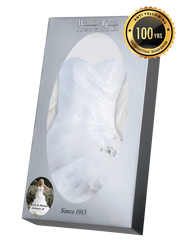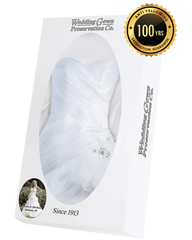We have a systematic process used to clean your gown. Upon arrival, we evaluate each gown to determine the best cleaning method. During the dress cleaning process your gown will be rotated around our racking system to "preservation stations" where each station focuses solely on one aspect of the cleaning process. Some of the processes focus on gentle dry cleaning, spot removal, beading, altering, pressing, and more. Your dress will be preserved using family formulas that has been passed down through 3 generations. Our preservation methods are recognized by International Fabric Institutes as the best methods in the gown preservation industry. Our process uses SystemK4 wedding gown cleaning technology that is 100% organic, so it is safe for your gowns’ fabrics. After the cleaning process is completed, your gown is carefully fitted around acid-free bust and placed in our acid free preservation paper. During the last steps your gown is sealed in our acid-neutral preservation chest, placed in a heavy, crush-proof shipping box for safety and to avoid damages to your gown, and sent out insured to you via UPS (signature required upon delivery).
Our fabric experts take pride in implementing every process possible and using the best cleaning process to remove a stain without risking fabric damage. Over the years we have a proven success record of removing 95% of stains found throughout the process — including dirt, blood, perspiration, grass, grease, food, sugar stains from cake icing, wine, and other beverages. If your wedding dress has a difficult, set-in stain, we use a multi step deep cleaning process to treat and remove the stain. While it is very rare, if a stain is unable to be removed we will reach out to you with the next further options that we can take to treat your gown. In the rare circumstance where we are unable to remove a stain, and we determined that further treatment and cleaning could damage the delicate fibers of your gown, you will be notified with a letter that will be included with your preserved gown explaining why the stain wasn't further treated and processed.












 200 Business Park Dr,
200 Business Park Dr,  (800) 830-4665
(800) 830-4665 info@trustedweddinggownpreservation.com
info@trustedweddinggownpreservation.com